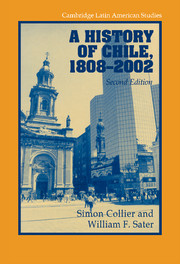Book contents
- Frontmatter
- Contents
- List of maps
- Preface to the Second Edition
- A note on geography
- CAMBRIDGE LATIN AMERICAN STUDIES
- PART I Birth of a nation-state, 1800s–1830s
- PART II The rise of a republic, 1830s–1880s
- PART III The nitrate era, 1880s–1930s
- PART IV Industrial advance and the dawn of mass politics, 1930s–1960s
- 9 The Radicals, the General of Hope, and the Lion's Son, 1938–64
- 10 The industrial impulse, 1930s–1960s
- PART V Democracy and dictatorship, 1960s–2000s
- Glossary of Spanish terms
- Initials and acronyms
- Further reading
- Index
10 - The industrial impulse, 1930s–1960s
Published online by Cambridge University Press: 05 June 2012
- Frontmatter
- Contents
- List of maps
- Preface to the Second Edition
- A note on geography
- CAMBRIDGE LATIN AMERICAN STUDIES
- PART I Birth of a nation-state, 1800s–1830s
- PART II The rise of a republic, 1830s–1880s
- PART III The nitrate era, 1880s–1930s
- PART IV Industrial advance and the dawn of mass politics, 1930s–1960s
- 9 The Radicals, the General of Hope, and the Lion's Son, 1938–64
- 10 The industrial impulse, 1930s–1960s
- PART V Democracy and dictatorship, 1960s–2000s
- Glossary of Spanish terms
- Initials and acronyms
- Further reading
- Index
Summary
… a New World country with the social organization of old Spain, a twentieth-century people still preserving a feudal society; a republic based on the equality of man, yet with a blue-blood aristocracy and a servile class as distinctly separated as in any of the monarchies of the Old World. Throughout Chile's history this situation has existed. It is this social heritage that forms the background for the present-day problems of the Chilean people.
– George McBride (1936)Underlying the competition of the parties during the Radical presidencies, and those of Ibáñez and the second Alessandri, there was the whole issue of economic development, as we now call it. The Chilean population was growing, and Chileans were no longer willing to accept the limited horizons of their parents and grandparents. They needed to find a place in Chile, or face the prospect of emigration – like those thousands who had earlier departed for the guaneras of Bolivia, the railroads of Peru, the pampas of Argentina, or M. de Lesseps's Panama Canal. They were as affected as anyone else by the twentieth-century “revolution of rising expectations,” aspiring to share the lifestyles enjoyed by other peoples -not least as images of the “developed” world reached them through the movies. Hollywood, as was often been remarked, was one of the true revolutionary forces of the twentieth century.
- Type
- Chapter
- Information
- A History of Chile, 1808–2002 , pp. 264 - 302Publisher: Cambridge University PressPrint publication year: 2004



